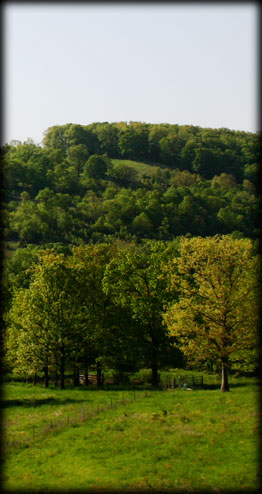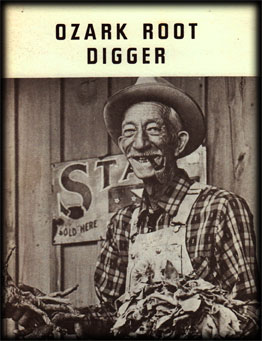The True Story of Bonnie Parker & Clyde Barrow
from Chick Allen
Bonnie Parker and Clyde Barrow were believed to have killed 12 men in two years and blazed a path of terror through the Ozarks in the early 1930s. Many persons, like Uncle Joe of Ozarks, never forgot the wanton killers.
He was going to the little store west of Reeds Spring called Sack 'n All City, to buy his weekly groceries. At this time, I, Chick Allen, was in the store, not knowing what was going on. Bonnie and Clyde were being chased by Stone County officers with two other men. They turned off a little country road west of Reeds Spring just as Uncle Joe, a mixed Indian, was crossing the road to the store.
“They stopped him and ordered him into the car.”
They stopped him near a neighbor's farm and said they were lost and ordered him to get into the car and show them the way to Arkansas. The car was full of guns and he got in the back seat between two men. Clyde was driving and Bonnie was beside him, an automatic rifle in her lap. They seemed real calm so Uncle Joe told them to drive to the Cape Fair road and turn toward Highway 43, which is now Highway 13, south of Reeds Spring. Just before they got to the junction, in a low gap near Yocum Pond, they saw a load of armed officers blocking the road ahead.
They were Galena men.
Bonnie cursed and said, "There they are. We might as well stop and have it out with them." They quickly got out of the car and started shooting the automatic rifles at several deputy sheriffs who dived under the car for cover as they had emptied their pistols. One of the bullets came through the windshield very close to Uncle Joe's head. Pellets from a shotgun were hitting all over the car. There was a terrible roar from the guns. About that time several deputies and the Reeds Spring marshal drove over the hill behind them.
One of the men with Uncle Joe turned his rifle on them and they backed their car out of sight. The outlaws got back into the car and gave it the gas. They ran into a ditch going around the officers car. Bonnie and the man in the back seat showered the car with bullets as they drove by.
“Uncle Joe was afraid they would think it was a trap.”
Bonnie cursed a lot. Uncle Joe was afraid they would think he had led them into a trap and would kill him. Joe was really scared because by this time no one was calm, but mean and hard. Uncle Joe told Clyde to turn south on Highway 43. They went about two miles and saw another carload of officers parked at the side of the highway. Clyde did not even slow down. Bonnie and the man in the back seat opened fire with the rifles as they passed. The officers ran.
When they got almost to Berryville, Arkansas, they stopped, gave Uncle Joe 10 dollars and told him to get out. Luckily they did not harm him, nor was anyone killed, but over in Joplin, Missouri, April 13, 1933, it was a different story. Officers found Bonnie and Clyde holed up in a house. Police and office patrolmen closed in and the Barrow Gang came out shooting as usual. Clyde was shot in the leg by a state patrol officer but two of his fellow officers were killed before the outlaws escaped. One law officer had 10 shotgun slugs in his neck and shoulder. Another officer fell from a shotgun blast that tore his right arm off at the elbow and buckshot filled his face and head. He died four hours later.
The killers roared south and escaped in the mountains. On April 6, 1934, Bonnie and Clyde drove into Commerce, Oklahoma, gunned down a constable and kidnapped the police chief.
The entire record of the vicious Bonnie and Clyde follows a similar pattern. They seldom holed up in one place longer than a few hours. They madly drove back and forth across the country from Texas to Ohio, robbing banks, store and service stations. They were always heavily armed and would start shooting at the first indication of a trap. They stole their cars, one after another. They out-gunned officers with their sawed-off shotguns and machine guns and seemed to have a charmed life.
“They seemed to have a charmed life...”
Clyde Barrow was born at Nacogdoches, Texas, and Bonnie was born in Dallas. They did not meet until he was 22 and she was 16. Clyde and his buddy had already gunned down three men when Bonnie and Clyde met in the Dallas cafe where she was a waitress. Bonnie's husband was in prison and she was Clyde's buddy's girlfriend. When she saw Clyde, she immediately changed her affection to him. Because of this, Clyde and his buddy dissolved partnership shortly after they kidnapped Uncle Joe in Stone County. By the time the last officer was killed in the list of murders, the situation had grown into America's biggest manhunt.
Continued above right...

plate 1. An Ozark Springtime, Photo credit, J. Heston. Location: rural Stone County, Missouri. May 5, 2008.

plate 2.
Few people in the vacation land of today...
Few people in the vacation land of today's Ozarks realize that this land was once the greatest outlaw breeding ground in America.
Most of the nation's notorious badmen for a hundred years, from 1835 to 1935, were spawned here in this mountain country — or came here to hide at some time in their careers.
It was called the Godless Land, with 60,000 square miles in which the poison breed hatched faster than they could be shot or hanged.
The Daltons, Belle Starr, the James Boys, Henry Starr, Jake Fleagle, Ma Barker, Clyde Barrow and Bonnie Parker, Pretty Boy Floyd, Quantril, Alf Bolen and the Baldknobbers were the most famous outlaws of the Ozarks.
— from Chick Allen

plate 1. These stories were first written and published by Chick Allen in 1975.
Pictured below, Allen is remembered as an Ozark historian and “root digger” a founding member of the Baldknobber Music Show, and, perhaps most importantly, as a deeply respected and loved father and grandfather.
It is with great appreciation to John Fullerton — Chick Allen's great grandson and Branson historian — that this excerpt is published.

plate 3.
Bonnie and Clyde (Continued):
A reward of $10,000.00 was on their heads dead or alive. On May 23, 1934, six Louisiana and Texas officers were hidden along a country road near Arcadia, Louisiana.
An underworld tip had warned that Clyde and Bonnie would pass by this spot.
They were on their way to contact a Louisiana hoodlum. At 9:15 a.m., a tan Ford nosed over the hills and came toward the officers. They had picked this spot carefully. Here Clyde would be forced to pass slowly. Their guns were ready. Clyde was driving with Bonnie beside him. They slowed down. The sheriff suddenly sprang to his feet. "Put 'em up Clyde, you're covered." The car leaped forward, six officers pulled triggers, pouring lead into the left front door. The car kept rolling and gunfire covered it from six angles.
“Clyde Barrow’s head fell backward and Bonnie slumped forward...”
Windshield and door glass was blown out. These men were shooting mad dogs, not humans. Clyde Barrow's head fell backward and Bonnie Parker slumped forward. The car rolled to a stop. The officers found Clyde's body beaten severely by a hail of lead. Bonnie had seven bullets in her face and 25 in her body and her right hand was nearly severed. In Clyde's lap was a sawed-off shotgun and Bonnie clutched a .45 automatic pistol. Between the pair was another shotgun. In the backseat were three Browning rifles with 40 clips of ammunition. Under a robe were 10 automatic pistols and one revolver. Three bags and boxes contained more than 2,000 rounds of ammunition.
The car had been stolen from Topeka, Kansas, and 15 sets of license plates were found in the back seat. Bonnie had changed the color of her hair many times during her crime career.
“At her death her hair was red and she wore a red dress and shoes.”
At her death it was red and she wore a red dress and red shoes. Her overnight case that contained lipstick, powder and rouge was found on the back seat with the guns. Clyde's shoes were on the floor of the car and he was driving in his socks. He had more than $500.00 in his pockets. The trail of the Bloody Barrows had run out — they had died as they lived — by fiery lead.
After Uncle Joe was released at Burryville, he figured he was through with the outlaws, but he was not. Clyde's buddy was captured a few days after Bonnie and Clyde were killed. Uncle Joe was called as a prosecuting witness at his trial. His testimony helped send the outlaw to the electric chair.
Uncle Joe had a friend who was a permanent citizen of Reeds Spring who went to Berryville and brought him home.



